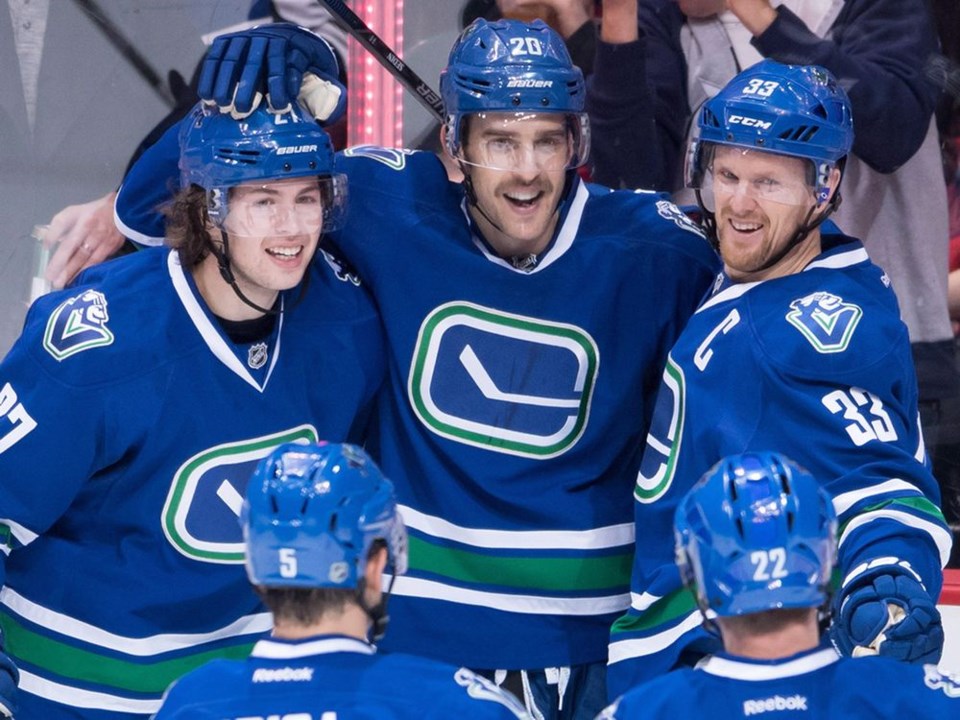The Vancouver Canucks finished 29th in the NHL in power play percentage last season, scoring just 32 goals on 227 opportunities. When you take into account the 6 shorthanded goals they gave up, the Canucks actually had the worst goal differential in the entire NHL with the man advantage.
It’s clear that something had to change and, given Willie Desjardins’ unwillingness to change the personnel due to “chemistry”, the change had to come to the coaching staff.
The Canucks announced on Wednesday that they were bringing back assistant coach Newell Brown to coach the power play. It’s a welcome announcement, as Brown was in charge of the power play for some of the Canucks’ best years with the man advantage.
The positive feelings evoked by Brown’s hiring ebbed slightly, however, during an appearance on TSN 1040 on Thursday. Brown gave some initial thoughts on power play personnel, praising the Sedins, Markus Granlund, Sven Baertschi, and Bo Horvat. But it’s what he said about Brandon Sutter that might worry Canucks fans.
“I think [Sutter] is a guy that can probably do what Kes did on the power play,” he said. “Be that right shot, bring the puck into the zone, be a player that can play in front of the net, take faceoffs on the right side, help out in that area.”
For those who were aggrieved by Sutter’s continual presence on the first power play unit last season, those are some alarming words. To be fair, Brown has an entire off-season to look at video, talk to players and coaches, and brainstorm power play formations, but these preliminary thoughts are way off-base.
To explain why, let’s go back to the first time Brown joined the Canucks.
The power play was already quite good when he joined the coaching staff in 2010-11: the previous year they had converted on 21.2% of their opportunities, good for fourth in the league. But with Brown at the helm, the power play reached new heights, leading the NHL at 24.3%
Brown’s systems, which emphasized movement, unpredictability, and a balance between left and right-handed shots, had a lot to do with their success, but his biggest contribution had to do with personnel. Brown loaded up the first power play unit, placing Ryan Kesler with the Sedins, Christian Ehrhoff, and Alex Edler.
This absolutely gutted the second power play unit, which was little more than a placeholder for when the first unit got tired. Mason Raymond felt the impact the most: he went from 8 goals and 18 points on the power play in 2009-10 down to just 2 goals and 6 points in 2010-11. Raymond actually scored more at even-strength in 2010-11, but faced harsh criticism for his drop in points and it was largely because of removing Kesler from the second power play unit.
But the move worked like gangbusters for the first unit. Daniel Sedin scored 18 goals and 42 points on the power play en route to the Art Ross Trophy. Kesler scored a career-high 15 power play goals and 41 total, the only time in his career he has scored more than 26.
Part of the reason why Kesler was so successful on the first power play unit is for the things Brown mentioned about Sutter: Kesler was a right-handed shot, had speed for gaining the offensive zone, could be a net-front presence, and could take faceoffs on the right side. But the bigger reason why Kesler was successful is that he was already an elite point-producer on the power play.
That’s where Kesler and Sutter are miles apart. In 2009-10, among NHL players with at least 50 minutes at 5-on-4, Kesler was 11th in power play points per 60 minutes. Kesler scored 12 power play goals from the second unit in 2009-10 and had 10 power play goals the previous season.
Adding Kesler to the first unit wasn’t a no-brainer — Canucks fans initially criticized the move because of how much it weakened the second unit — but the biggest reason it made sense is because he could produce points on the power play. Everything else — right-handed shot, speed, net-front, faceoffs — was all secondary: nice things to have and certainly contributed to his success, but not of primary importance.
Sutter, on the other hand, has all those secondary attributes, but not the primary one: he just doesn’t put up points on the power play. Among players who played at least 50 minutes at 5-on-4 last season, Sutter was 295th in power play points per 60 minutes.
Sutter’s career-high in power play points came in his second season in the league, when he managed 10 points. He hadn’t scored more than 5 power play points in six seasons before he put up 8 with the Canucks last year. And yet, he was third on the Canucks in power play ice time last season behind only the Sedins.
There are various reasons why Sutter isn’t effective on the power play. While he has a hard and accurate shot, he doesn’t have a quick release, so he can’t get his shot off fast enough against the pressure of an aggressive penalty kill. He’s a mediocre passer with below-average vision, so he doesn’t contribute meaningfully to puck movement. While fast, he doesn’t have great puck control, so he doesn’t always gain the zone effectively with possession. And, for someone his size, he regularly loses board battles, so he’s not effective at regaining possession of the puck once it has been lost.
But putting all of the whys and wherefores aside, the simple fact of the matter is that Sutter isn’t effective on the power play. As much as they have some superficial similarities, Sutter is not Kesler and he has no business being on the first power play unit.



